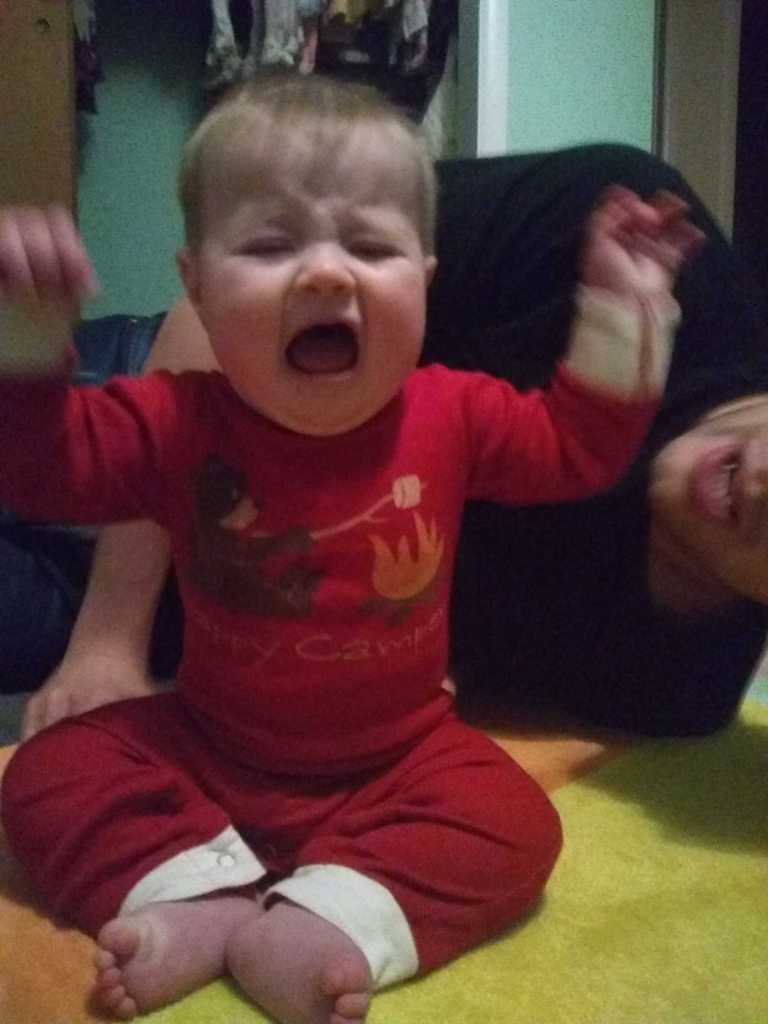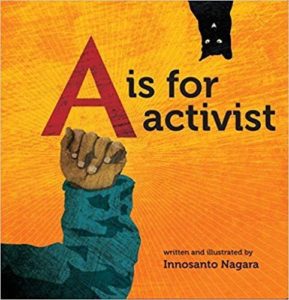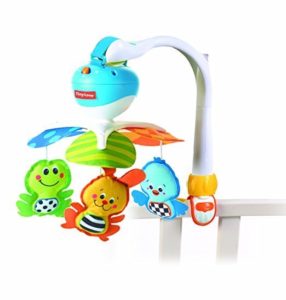Updated March, 2022
Above is one of my favorite pictures of Monster when they were very young. They are wearing an outfit that says “Happy Camper” on it while they throw a huge tantrum. If I recall correctly, their father had just told them the worst, most awful thing a baby can hear: “no”. Oh they were angry. And I’m sure it was something to do with safety. Despite their tantrum, we stuck with it. This is because children need boundaries, and adults telling them no for safety reasons is just one example. Setting boundaries for children is important because, despite their very vocal protests, it can actually make them feel safer.

Boundaries are Safe
Most people need boundaries and this includes our children. It is important to set boundaries early on so that your child knows what is and is not acceptable or safe. Setting these boundaries can help you avoid behavior such as hitting, kicking, biting, putting feet on the table, or even playing with cords. As they get older, these boundaries will look like staying out of the street and not touching hot appliances. By the time they are teens, your child will be so used the the communication expectation that it doesn’t even feel like a boundary to them. Boundaries, both in respecting them and setting them, are a necessity in life ans something your child will navigate forever.
Boundaries help children feel safe. If a child feels safe, they are better able to play, engage with the world, and get lost in their imagination. If they are always worried about what is next or how their parent is going to act or if their environment is safe, they can’t truly let go. Boundaries let children know exactly how far from their parent they can go (physically, emotionally, and mentally) while still staying safe.

Which Boundaries to Set
I can’t pretend that every single family is going to have the same boundaries because it simply isn’t true. You do want to decide together which boundaries are most important to you. And just because you set boundaries today doesn’t mean you never revisit them again. This conversation will be on going and should be intentional.
Safety
The most important boundaries to set are ones surrounding safety. These are the ones that help ensure your child and your family are safe. These are the ones where they have to hold your hand to cross the street or they need to be in your line of sight when taking a walk.
Behavior
Boundaries surrounding behavior have a little to do with manners, but are mostly about learning to listen to and respect the boundaries of others as well as to make boundaries for themselves. I know too many adults who are terrible at setting boundaries. Behavior boundaries are the ones where we say you cannot yell at me or you cannot touch me without my permission. Note that behavior boundaries go both ways. If you don’t want your child to yell at you, pay attention to how you are regularly addressing them.
Family
Deciding which boundaries are important to the people in your family is important so that everyone is on the same page. For example, at home, we don’t really care if Monster puts their feet on the table while they eat (we usually have our own propped on chairs across from us) but we are not okay with them playing with cords for our electronics. Know what is important in your household and stick to it.
Family boundaries are also good because it can show your child that adults set boundaries with each other as well. Again, this is a lifelong process, not just about having control over your child.

Setting Boundaries
If your children are very young, it’s easy to start setting boundaries. Know what you want and express it regularly. If boundaries are new to your family and your children are older, you may need to have more of a conversation.
Clear and Simple
The first rule to setting boundaries is that you have to keep them clear and simple. Try to keep it to a short phrase or sentence. Don’t add in a bunch of nuances such as when they can break the rules or push outside of the container. You want to be able to remind them easily, and even have them remind you eventually.
Consistent
Make sure you are consistent at all times. One Monster’s birthday, they asked for something and I said no. Full scale meltdown, tears, the whole nine yards. It was so hard for me to deny them what they wanted on their birthday, but it was important to stay consistent. As early as 8 months, if Monster hurt one of us on accident, such as by hitting or biting, we would exaggerate our reaction, remarking that it really hurt. At only 1, Monster was demonstrating empathy and would give a hug or cuddle to someone if they were the cause of that person’s pain.
The tantrums won’t be easy. The tears and the yelling will be frustrating. The blatant sweetness as an attempt at manipulation can be annoying (or wonderful and hard to say no to). Make sure you stay gentle but firm. A simple “no”, and potentially moving your child away from the problem should suffice. If your child needs to throw a tantrum, especially if you are at home, make sure they are in a safe space and just let them. Don’t change your answer, they still can’t hit or throw or whatever it might be, but it is okay for them to be upset.
Part of consistency is that even in play some things are unacceptable. If you do not want your child to hit, do not allow them to playfully hit you either. And boundaries go both ways. If your child is not allowed to hit you, you are not allowed to hit them.
Setting New Boundaries
There will be times when you need to set new boundaries with your children. This could be because of their age or a new behavior that has come up. Just because you have decided there needs to be a new boundary doesn’t mean it won’t take time.
One of my favorite things to do with my children when they need a new boundary is to sit down together and write it out. This could be a brainstorming session, or something I write and they copy. It all depends on the mood. Then we hang it on the wall near our table and review it every day at dinner time.
Examples
- Monster, Sprinkle and I sat down together and made a Rules chart. We came up with 7 rules around how we were to behave in the house and with each other. Some of the rules were for them and some of them were for me. They would act out and I would get so angry I would want to do things like throw their toys away. So we made rules such as “control our bodies”, “everyone cleans”, “being angry is okay and you are still responsible for your actions”, and “it is never too late to apologize”. We reviewed them every day for a month. Now we refer to them if we feel someone needs reminding.
- Monster picked up some terrible behaviors at one of their schools. There was yelling, throwing, screaming, the works. So we created a consequences chart. Just the two of us sat down together and reviewed the unacceptable behavior and wrote it down under “If”. Then we wrote “Then” and together we brainstormed their consequences. Ultimately, it was decided that I would pick their activities for the rest of the day. It made them feel control and it also gave them the option to act out if they really needed to, with a clear understanding of what the consequences would be.
- The trauma from Monster’s last school left a lasting impression in the form of simmering anger. We both felt they needed time and space to get that anger out but in a safe way. So we made a chart titles “When I’m Angry”. On one side we wrote “yes” and the other we wrote “no”. Together we brainstormed as many ways as we could think of to express anger that were okay and not okay. Monster has even added things to it, such as going in their room and listening to music really loud.
- As a single mom I need routine for my sanity, so I set the expectations around meal times for what they can and cannot do. We wrote out a step by step process for what the routine after dinner was to look like. Now from “ask to be excused” all the way to “bed” we all have something to refer to in order to know what is next.
The Dreaded "No"
The no phase is one many parents dread with their who bodies. You need to do xyz and your child responds with a very firm “NO!”. Well I promise you, your children learned to say no from somewhere. Be aware of what you are saying to your child and how you sound before you as them to speak to you in a specific way.
Alternatives to No
Instead of always saying no, try offering your child alternatives or look for different ways to tell them what you want them to do. If they can’t throw things in the house, remind them that you throw balls outside. If they want dessert right now, remind them that they need to eat dinner first. There are a lot of gentle ways you can tell your child what is allowed without ever using the word “no”. We try to reserve no for the very serious matters, so that our child knows their behavior has to stop immediately, such as with hitting.
Natural Consequences
Often we put boundaries in place in order to keep our children safe. Sometimes though, our children need to be given small, safe opportunities to test boundaries to see what happens. These are what I like to refer to as natural consequences. They aren’t a punishment, and your child isn’t in trouble. It is just what happens when they do not respect boundaries of you or others.
One common natural consequence is other people’s reaction to them. If your child hurts others or won’t listen, then it is very possible that other children will not want to play with them. I never require children to be friends with each other or to play with each other. If a child is hitting, there is a good chance the other kids will start to avoid them. If they won’t share, the other kids might cry and tell their parents. This is a safe, natural, social consequence.
Redirection
Finally, redirecting is going to be a lifesaver, especially for the toddler age. If your child is stuck on a behavior that is unacceptable, sometimes they may need help to find a new activity. This could be the thing they are trying to do but in an appropriate way, such as going outside to kick their ball or yell, or building their own tower to knock down. Often though, especially with younger children, offering them something different to do can change their focus enough that whatever poor behavior they were demonstrating previously is no longer important to them.

Testing Boundaries
Around one your child is going to start testing those boundaries more often. They will try acting sweet, they will try throwing a fit, they will try asking another person. Anything they can think of to change your mind, they will try. This is normal and healthy. It is important not to punish boundary testing, but to stay consistent.

Growing with Boundaries
Your child won’t be a toddler forever. As they grow, the boundaries you have set with them might change or increase. Perhaps they don’t have to hold your hand to cross the street anymore, but they are expected to communicate with you when they go out.
Boundary setting is a life long lesson. Practice these now so that your child can set and respect their own boundaries as they grow.
Need Support?
Need support setting appropriate boundaries with your child? View my Early Childhood Behavioral Support page to set up a free consultation. Together we can create and implement a behavioral plan that is right for you and your child.











